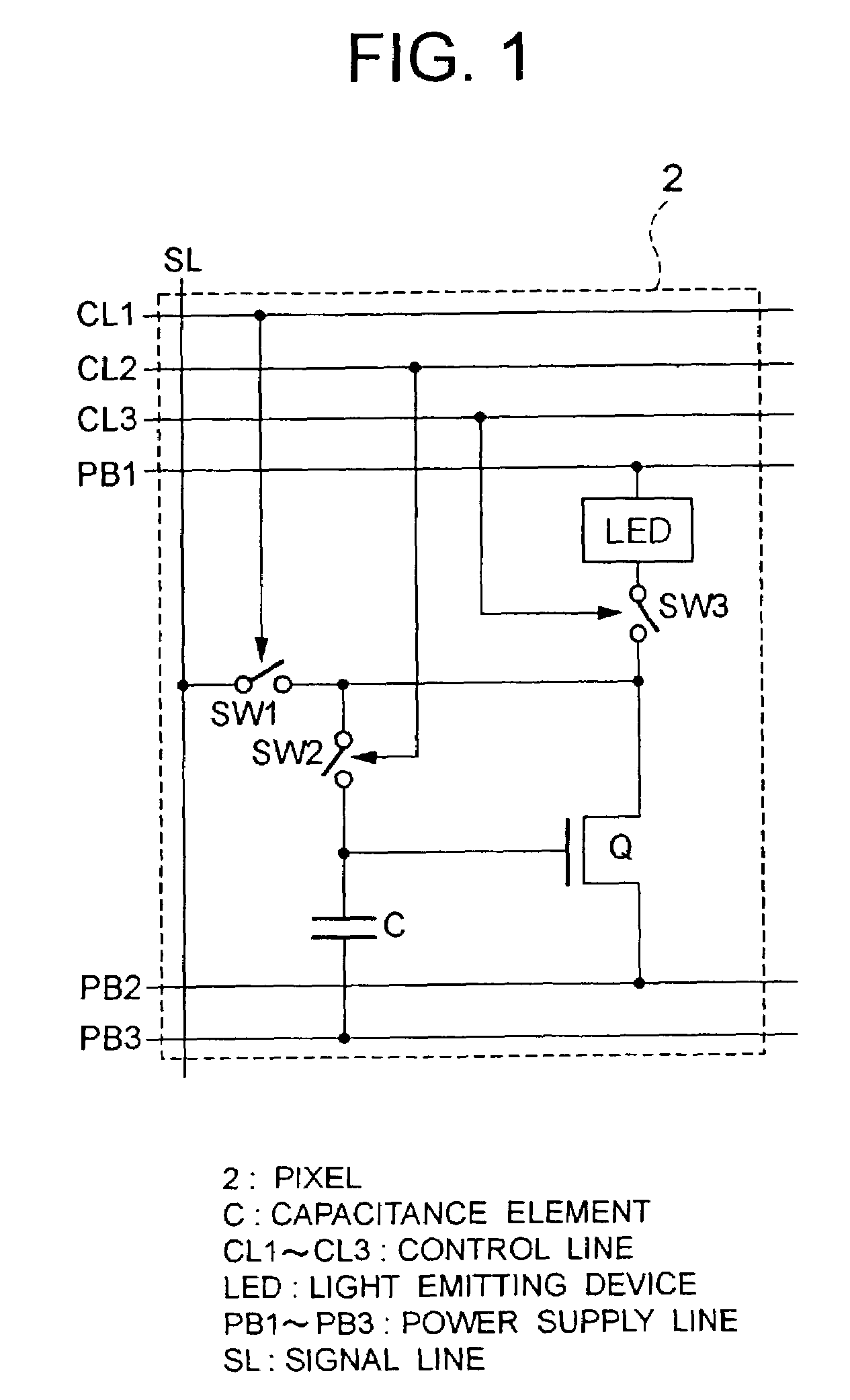Current load device and method for driving the same
- Summary
- Abstract
- Description
- Claims
- Application Information
AI Technical Summary
Benefits of technology
Problems solved by technology
Method used
Image
Examples
first embodiment
[First Embodiment]
[0066]FIG. 1 is a circuit diagram showing a configuration of one pixel according to a first embodiment of this invention. As shown in FIG. 1, a signal line SL extending in a column direction, control lines CL1 to CL3 extending in a row direction and voltage supply lines PB1 to PB3 run through a pixel 2, and a TFT Q, switches SW1 to SW3, a capacitance element C and a light emitting device LED are arranged in the pixel 2. A first terminal of the TFT Q, which is one of the drain or source thereof, is connected to the voltage supply line PB2, the switch SW3 is connected between a second terminal of the TFT Q, which is the other of the drain or source thereof, and the light emitting device LED, and the switch SW1 is connected between the second terminal of the TFT Q and the signal line SL. A terminal of the light emitting device LED on the other side of the switch SW3 is connected to the voltage supply line PB1. The switch SW2 is connected between the second terminal an...
second embodiment
[Second Embodiment]
[0082]FIG. 5 is a circuit diagram showing a configuration of one pixel according to a second embodiment of this invention. As shown in FIG. 5, a signal line SL extending in a column direction, control lines CL1 to CL3 extending in a row direction and voltage supply lines PB1 to PB3 run through a pixel 2, and a TFT Q, switches SW1 to SW3, a capacitance element C and a light emitting device LED are arranged in the pixel 2. A first terminal of the TFT Q, which is one of the drain or source thereof, is connected to the voltage supply line PB2, the switch SW3 is connected between a second terminal of the TFT Q, which is the other of the drain or source thereof, and the light emitting device LED, and the switch SW1 is connected between the second terminal of the TFT Q and the signal line SL. A terminal of the light emitting device LED on the other side of the switch SW3 is connected to the voltage supply line PB1. The switch SW2 is connected between the signal line SL a...
third embodiment
[Third Embodiment]
[0089]FIG. 7 is a circuit diagram showing a configuration of one pixel according to a third embodiment of this invention. As shown in FIG. 7, a signal line SL extending in a column direction, control lines CL1 to CL3 extending in a row direction and voltage supply lines PB1 to PB3 and PB5 run through a pixel 2, and a TFT Q1, a TFT Q2, switches SW1 to SW3, a capacitance element C and a light emitting device LED are arranged in the pixel 2. The TFT Q1 and the TFT Q2 are connected in series, one of the drain and source of the TFT Q2, which is not connected to the TFT Q1, is connected to the voltage supply line PB2, the switch SW3 is connected between the light emitting device LED and one of the drain and source of the TFT Q1, which is not connected to the TFT Q2, and the switch SW1 is connected between the signal line SL and the terminal of the TFT Q1, which is not connected to the TFT Q2. A terminal of the light emitting device LED on the other side of the switch SW3...
PUM
 Login to View More
Login to View More Abstract
Description
Claims
Application Information
 Login to View More
Login to View More - R&D
- Intellectual Property
- Life Sciences
- Materials
- Tech Scout
- Unparalleled Data Quality
- Higher Quality Content
- 60% Fewer Hallucinations
Browse by: Latest US Patents, China's latest patents, Technical Efficacy Thesaurus, Application Domain, Technology Topic, Popular Technical Reports.
© 2025 PatSnap. All rights reserved.Legal|Privacy policy|Modern Slavery Act Transparency Statement|Sitemap|About US| Contact US: help@patsnap.com



